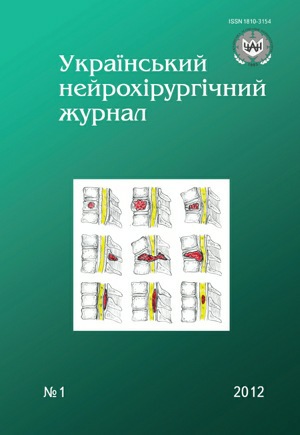Application of epidural electrostimulation to treat bladder dysfunction in patients with consequences of traumatic injury of lumbar and sacral segments of the spinal cord
DOI:
https://doi.org/10.25305/unj.57757Keywords:
spinal cord injury, bladder dysfunction, restorative treatmentAbstract
Background. Bladder dysfunction is one of the most frequent and severe clinical manifestations of traumatic disease of the spinal cord, which causes chronic inflammatory processes in the urinary tract and impairs the quality of life of a patient.
Methods. The results of correction of bladder dysfunction after epidural electrostimulation in 69 patients with consequences of spinal cord injury of lumbar and sacral segments of the spinal cord are presented. The degree of urination control was evaluated (none, partial, complete) before and after applied treatment.
Results: in group A partial urination control was achieved in 45% of patients, in group B — in 61.5%, in 1 (7.7%) patient bladder control function restored completely. In group C a positive result in restoration of bladder function was achieved in 89.6% of patients, in group D — in all patients. It was incontinentia vera, at which we achieved best results of correction, 90.5% of patients showed positive results.
Conclusions. Epidural electrostimulation is an effective method of correction of bladder dysfunction in patients with consequences of traumatic injury of spinal cord lumbar and sacral segments.
References
1. Krupin VN, Belova AN. Neyrourologiya [Neurourology]. Moscow: Antidor; 2005. Russian.
2. Tsymbalyuk VI, Yaminskyy YuYa. Rekonstruktyvno-vidnovna khirurhiya spynnoho mozku [Reconstructive surgery of the spinal cord]. Kiev: Avitsena; 2009. Ukrainian.
3. Weld KJ, Dmochowski RR. Association of level of injury and bladder behavior in patients with post-traumatic spinal cord injury. Urology. 2000 Apr;55(4):490-4. [CrossRef] [PubMed]
4. Astapenko VA, Likhachev SA, Zabrodets GV. Neyrogennyy mochevoy puzyr: patogenez, klassifikatsiya, klinika, diagnostika, lecheniye [Neurogenic bladder: pathogenesis, classification, clinic, diagnostics, treatmen]. Meditsynskiy Zhurnal (Belarus). 2002(2):15-8. Russian.
5. Harrop JS, Hunt GE Jr, Vaccaro AR. Conus medullaris and cauda equina syndrome as a result of traumatic injuries: management principles. Neurosurg Focus. 2004 Jun 15;16(6):e4. [CrossRef] [PubMed]
6. Gerasimenko Y, Roy RR, Edgerton VR. Epidural stimulation: comparison of the spinal circuits that generate and control locomotion in rats, cats and humans. Exp Neurol. 2008 Feb;209(2):417-25. [CrossRef] [PubMed]
7. Hernández-Labrado GR, Polo JL, López-Dolado E, Collazos-Castro JE. Spinal cord direct current stimulation: finite element analysis of the electric field and current density. Med Biol Eng Comput. 2011 Apr;49(4):417-29. [CrossRef] [PubMed]
8. Walters BC. Oscillating field stimulation in the treatment of spinal cord injury. PM&R. 2010 Dec;2(12 Suppl 2):S286-91. [CrossRef] [PubMed]
9. Oakley JC, Prager JP. Spinal cord stimulation: mechanisms of action. Spine (Phila Pa 1976). 2002 Nov 15;27(22):2574-83. [CrossRef] [PubMed]
10. Zan E, Kurt KN, Yousem DM, Christo PJ. Spinal cord stimulators: typical positioning and postsurgical complications. AJR Am J Roentgenol. 2011 Feb;196(2):437-45. [CrossRef] [PubMed]
Downloads
Published
How to Cite
Issue
Section
License
Copyright (c) 2012 Iuriy Iaminskiy

This work is licensed under a Creative Commons Attribution 4.0 International License.
Ukrainian Neurosurgical Journal abides by the CREATIVE COMMONS copyright rights and permissions for open access journals.
Authors, who are published in this Journal, agree to the following conditions:
1. The authors reserve the right to authorship of the work and pass the first publication right of this work to the Journal under the terms of Creative Commons Attribution License, which allows others to freely distribute the published research with the obligatory reference to the authors of the original work and the first publication of the work in this Journal.
2. The authors have the right to conclude separate supplement agreements that relate to non-exclusive work distribution in the form of which it has been published by the Journal (for example, to upload the work to the online storage of the Journal or publish it as part of a monograph), provided that the reference to the first publication of the work in this Journal is included.









